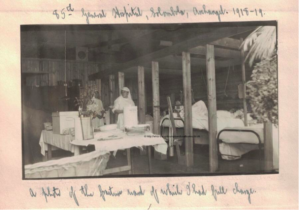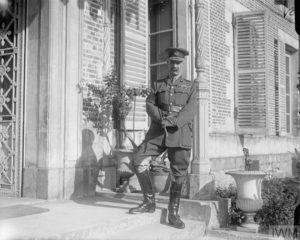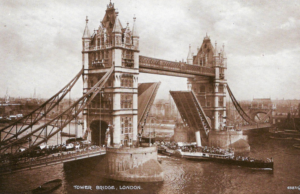Monthly Archives: August 2019
26th August 1919 Tuesday
The Highland Light Infantry and a Dance
All material produced or reproduced here and throughout this work is the sole copyright of the author and the family of Doctor D.C.M. Page MC
“On August 26th a transport arrived with the 2nd Battalion H.L.I. on board. It was good to see the ‘Jocks’ again. I knew they would be needed out here sooner or later. At night we held a grand dance in the Hospital. One of the big wards was utilised as a ball-room, and we had it beautifully decorated with flags and evergreens. Some of the side wards were used as refreshment rooms, and sitting out rooms. A huge crowd turned up including the D.D.M.S., A.D.M.S. and other officers. The Russian Naval Band supplied the music, which was excellent. The evening was a huge success. We finished at midnight with ‘Auld Lang Syne’.”
The Highland Light Infantry were a fearsome fighting unit emanating from Glasgow, Scotland. After being involved throughout World War 1, fighting in famous operations such as Neuve Chapelle in 1915 and the 2nd Battle of Ypres, the HLI had acquired a deserved reputation for being a regiment with high achievement. They had been retained in Germany until April 1919, after which they returned home to Glasgow. In the middle of August their presence was required to help finish the job in Archangel with things being cleared up and they remained there until the end of the year, enabling the regiment to add Archangel 1919 to the regiment’s battle honours.
![BuzzWeiser196 [CC BY-SA 4.0 (https://creativecommons.org/licenses/by-sa/4.0)]](http://whiz-bangskrumpsandcoalboxes.co.uk/wp-content/uploads/2019/08/Cap_Badge_HLI-283x300.jpg)
HLI Cap badge BuzzWeiser196 [CC BY-SA 4.0 (https://creativecommons.org/licenses/by-sa/4.0)]
23rd August 1919 Saturday
Packing Up
All material produced or reproduced here and throughout this work is the sole copyright of the author and the family of Doctor D.C.M. Page MC
“We closed down our hospital on the 23rd August, and were busy after that in finding something to do to kill the time. We played bridge a lot and went for long walks.”

Find out about our connection with Dr Page and an introduction to his diary here
17th August 1919 Sunday
“Rawly” Pays a Visit
All material produced or reproduced here and throughout this work is the sole copyright of the author and the family of Doctor D.C.M. Page MC
“General Lord Rawlinson and his staff and many other red, blue and green tabs paid us a visit on the 17th. We all had tea in the Recreation Room afterwards. The General shook hands with me, and was surprised when I told him that I’d been out here a year. I hope he gets a move on and sends me home soon!”
The “red blue and green tabs” gorget patches were mentioned on the 20th December 1915. However, the red blue and green tabs could have been from varying origins, most likely red were the Officers of the General Staff also with variations Royal Artillery and Royal Engineers. Blue had various incarnations with different shades and trimmings possibly signifying medical staff colonels, Pay corps, or Instructors. Green could represent Dentists or Intelligence officers. It seems many departments were represented on the visit.
Find out about our connection with Dr Page and an introduction to his diary here
11th August 1919 Monday
“Rawly” Arrives
All material produced or reproduced here and throughout this work is the sole copyright of the author and the family of Doctor D.C.M. Page MC
“About this time strong rumours of the British evacuation shortly of Archangel and district were going about. I heard that all British civilians had been ordered, or advised to leave within a month. Several British families, including the Carrs, (of Steuart’s timber yards) left on the 11th August.
I heard about this time too some details of the Bolo success at Onega, which village on the White Sea was taken from us recently. The Bolo success was, as usual, due to the fact that our gallant Russian Allies deserted us at the critical moment. Some of these deserters were being brought to Archangel on the ‘Walton Belle’ when they mutinied, and killed the British sergeant in charge, and wounded others of the escort. H.M.S. ‘Fox’ luckily arrived on the scene, and the O.C. sent an armed party aboard. They saw red, and not one of these Russian traitors lived to tell the tale.
On Monday August 11th General Rawlinson and his staff arrived on board the ‘Czaritza’. He has come out to superintend the safe evacuation of the British forces – so rumour has it. At our Hospital we have closed down most of the wards, and have stared packing up some of the equipment.“
Another paddle steamer brought to cope with the shallow waters of the Dwina was the Walton Belle, a smaller boat than the London Belle that we dealt with on the 2nd August. London Belle had been fitted with 165 beds and less were fitted into the Walton Belle. The diary of seaman Ethelbert Daish http://ethelbertsdiary.co.uk/?page=home confirms that paddle steamers had to make the journey out in short hops, clearly to take on supplies, water and fuel in order to make such a long trip. I heartily advise readers to visit the online diary to further their experience and knowledge of the North Russian expedition. Ethelbert tells us further of unrest and mutiny. Thank you to our Archangel correspondent Dmitry Bychiknin for alerting us to this diary.
HMS Fox was mentioned on the 15th May and Czaritza on the 26th/27th May.
The arrival of General Rawlinson saw one of Britain’s top military men come to oversee the withdrawal of the allied forces. It’s difficult to understand why it was necessary to send for a hero of the Boer War, Neuve Chapelle, The Somme and many other battles throughout the conflict on the Western Front the most experienced and battle hardened General the British army possessed when the operation in northern Russia was coming to a close. However, it must have been a boost to moral to have one of Britain’s most experienced Generals arriving to take over operations.
Known as Rawly to his confidents, General Sir Henry Seymour Rawlinson now simply Lord Rawlinson had excelled in his duties during the Second Boer War and worked his way steadily through the ranks. By the beginning of the Great War he had achieved the rank of Major General although this was by the usual British method of promotion, temporary and Brevet ranks. This was the British army’s normal way of promotion by giving an honorary position which came with the power of rank, but not the pay grade. Only permanent gazetted promotion to a rank ensured that the appropriate pay accompanied the title. So it wasn’t until 1917 that he was given the permanent rank of General, following all his successes and failures over the course of the war.
1918, however brought most of his military successes with his victories at the Battle of Amiens. By now General Hubert Gough had been relieved of his command and Haig had given Rawlinson almost complete command of the allied forces in France. Lessons of the Somme and Passchendael had been learned, but German moral at this time was at a very low ebb. The German commander Ludendorff described Amiens as a “Black day for the German Army”.
So the arrival of Rawlinson, one of the most famous men of WW1 would have been seen by the men remaining in Russia as a high point and resulted in a lifting of spirits.

British Army General Henry Rawlinson at his Fourth Army headquarters at Querrieu Chateau.
(Q 4032) © IWM. Original Source: http://www.iwm.org.uk/collections/item/object/205125115
Find out about our connection with Dr Page and an introduction to his diary here
2nd August 1919 Saturday
A Jittery Time in Archangel and Solombola
All material produced or reproduced here and throughout this work is the sole copyright of the author and the family of Doctor D.C.M. Page MC
“Saturday, August 2nd, was a day of terrific ‘wind-up’ with us. G.H.Q. spies had informed us that this was the day on which the British, especially the officers were to be wiped off the map! Our Commanding Officer was in a terrific state of alarm! He had convalescent patients busy for several days beforehand putting up barbed wire entanglements all round the hospital. On our mess balcony a sand-bagged machine-gun emplacement was built, and armed sentries were posted all over the place. These men didn’t know how to handle a rifle, and I quaked when I passed them by even in daylight. We were all put through a course of machine-gun drill, but I’m afraid none of us would have been of much use with the gun, if the necessity had arisen. Lt. Commander Richardson, my naval friend, was in charge of a hospital ship, ‘The London Belle’. lying off Solombola ready to take all our patients on board if necessary. American sailors, armed to the teeth, patrolled the streets all day, and British armoured cars dashed about at top speed. Archangel was deserted, many civilians having fled to the country, fearing trouble. Of course nothing happened. Some of the red-tabs at G.H.Q. must have a guilty conscience!”
Commander Richardson* our heroic naval character was in command of the paddle steamer London Belle at this time. This was a remarkable thing because she was such a tiny vessel. Tiny, but the Navy realised that it was exactly what they needed on the treacherously difficult Dwina. Frozen for eight months of the long winter, the summer was equally demanding. The water level steadily dropped throughout the hot summer making navigation for all but almost flat bottomed boats impossible and small paddle steamers with their low draft were ideally suited. The added difficulty would have been sailing the tiny craft on such a long journey from its home waters of London’s Thames to Archangel. It must have taxed the coal fuel capacity to its limits.
London Belle was launched on the 10th March 1893 by William Denny Bros. of Dumbarton for the London, Woolwich and Clacton-on-the-Sea Steamboat Company Ltd., She was built for use as a passenger steamer on the River Thames as an alternative to the railways for journeys to Southend and Clacton, becoming popular with day trippers, leaving Fresh Wharf at 09.30 daily. Fresh Wharf was situated on the north side of the Thames between Tower and London bridges. It closed in 1970.
The London Belle at 738 grt tons was the largest of the steamers used on this service. Even though she was over 280 ft (85.5 mtrs) in length, it was still a tenth of the size of the Kalyan. The Navy requisitioned her for use as a minesweeper in 1916 before returning her to her then owner the Coastal Development Corporation Ltd. in May 1919 only to take her straight back and send her to Archangel for use as a hospital ship.
She was eventually demobilised in 1920. Eventually being broken up on the Thames in 1929.

London Belle passing under Tower Bridge en-route down river. (An uncredited postcard)
Find out about our connection with Dr Page and an introduction to his diary here